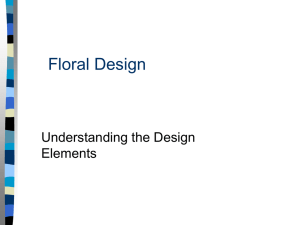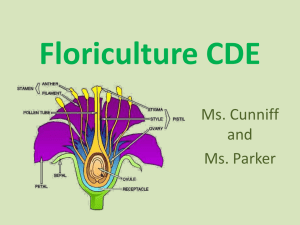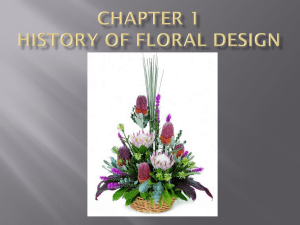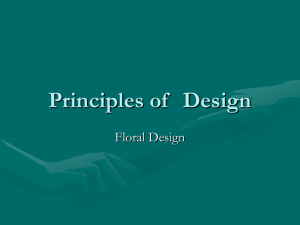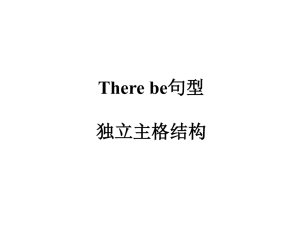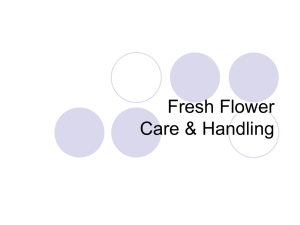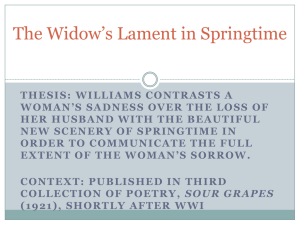PPT
advertisement
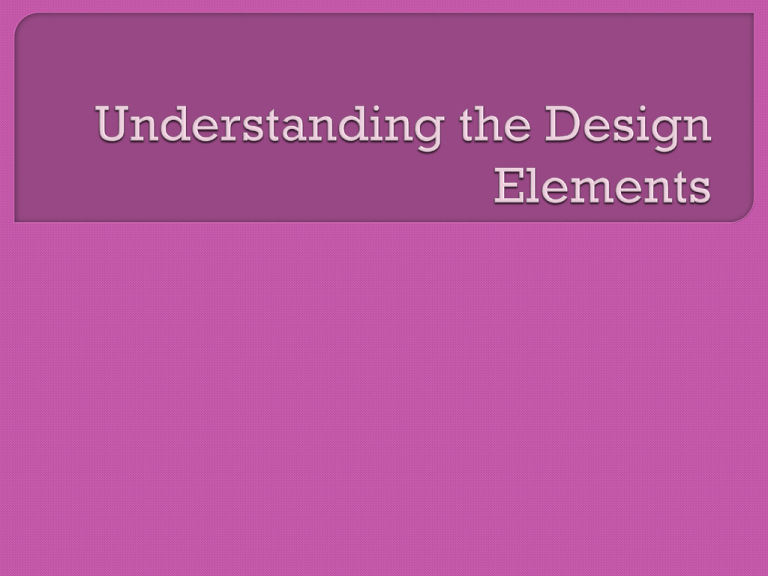
1. I can list and describe the major forms (or shapes) used in floral design. 2. I can explain how space and depth enhance floral design. 3. I can describe the importance of texture in floral design. 4. I can explain how color influences floral work. Advancing Analogous Color color wheel Complimentary Depth Design elements Filler flowers Form Form flowers Free form Geometric Line Line materials Mass flowers Monochromatic Naturalistic Polychromatic Primary colors Receding color Secondary colors Shape Space Work in pairs to compare and contrast the different arrangements. Discussion the shape, color, texture, and size of arrangements. Would the arrangements have the same visual effect in a different color? Why or why not? Floral arrangements are composed of flowers, greenery, and containers. These different elements can be arranged in various ways to create visually pleasing compositions. The physical characteristics that the designer uses to create the arrangements are called design elements. The design elements that must be understood when first creating floral arrangements are form and shape. Form refers to the 3-dimensional outline of the arrangement, while shape refers to the 2-dimensional aspect of form. Form, or shape can exist naturally in floral design elements, or they can be created by the designer. The common forms used in floral design are: naturalistic, free form, and geometric. The geometric shapes used in floral design are most often the circle and the triangle. These basic shapes can be varied to create ovals, fans, or crescent arrangements from the circle and right triangles, scalene triangles and isosceles triangles from the basic triangle. Naturalistic designs mirror the natural growth of plant material. Designs that exhibit this form often include groupings of plant material, using branches to symbolize trees and shorter flowers as undergrowth A free form arrangement is more contemporary, allowing the designer to take on any liberty with color, shape, and placement. Free form arrangements are very creative and do not have to follow any particular design rule. All forms of arrangement are created through the use of lines. Line is the visual movement between two points in an arrangement. The placement of the lines can help create a shape or express an emotional response. Lines can be created through the use of line materials. Line materials like snapdragon , liatris, and scotch broom are used to create very definite vertical, horizontal, diagonal, or curvilinear lines. The remainder of the arrangement is created through the combination of form flowers, mass flowers, and filler flowers. Form flowers are those flowers that have distinctive shapes like lilies or tropical flowers. Mass flowers are round, solid flowers like carnations and mums. The last category of flowers, filler flowers are light, airy flowers like baby’s breath and sea lavender that fill in the space between other flowers. By combining any number of line flowers, mass flowers, form flowers, and filler flowers, a designer has an infinite number of ways to create an attractive, eye-catching, visually pleasing arrangement. Almost as important as the placement of individual flowers, is the areas in the design where there are no flowers. Areas that are devoid of flowers are called space. It is important for the floral designers to leave space in their arrangements. Designers can also increase the apparent size of a design by adding space and depth to the design. Depth in a design gives the arrangement more of a three dimensional form than just a shape. By tucking flowers in further so they are partially hidden by others, dangling flowers upward or to the side, a designer can add interest and character to the arrangement. Space is very important in arranging. By placing the flowers away from each other, not touching, the arrangement appears to be larger but no more materials have been used. When this technique is used, the designer can save money by creating the illusion of a larger, more expensive design. By having space among the individual flowers, the visual attributes of each flower are then showcased. This allows for added interest in the design. Floral designers can create visually attractive arrangements by combining plant material with different texture. Texture is the design element that refers to the surface quality of the plant material Plant material can be rough, smooth, leathery, velvety, satiny, or hairy. Plant material is also described as having visual texture. The materials look fine or airy, lacy, delicate, or bold and coarse. By varying the textures in an arrangement, the arrangement can attract attention and hold the viewer’s interest for longer periods of time. Color is probably the most obvious element in design. A beautifully arranged floral arrangement can lose its appeal if the color combination is not striking. Physiological studies have shown that colors actually help contribute to people’s feelings. Colors have also come to symbolize certain occasions or events. For example, red has become the symbol for love, while yellow often means friendship or happiness. Green is very restful and symbolizes life, while blue is very cooling. Other colors are white for purity and innocence, purple for royalty, and orange for warmth. Made up of 12 colors Six colors make up the visible light spectrum called primary and secondary colors Intermediate or tertiary colors are created when primary colors are mixed in equal amounts with an adjacent secondary color. Make your own color wheel Floral designers often use basic color schemes in order to create eye-catching arrangements. Color schemes are created through the combination of one or more colors. A monochromatic color scheme would be made from one color and all its light and dark variations. For example, if red was the chosen color, the arrangement might include deep red, maroon, pale pinks, and hot pinks. All of these colors originate from the primary color red. Analogous color schemes use colors that are next to each other on the color wheel. An arrangement made of yellow, yelloworange, and orange would be analogous. By choosing two colors that are opposite each other on the color wheel, a complimentary color scheme is created. Red/Green, Violet/Yellow, and Blue/Orange are all complimentary color schemes. A polychromatic color scheme includes a wide range of colors.

